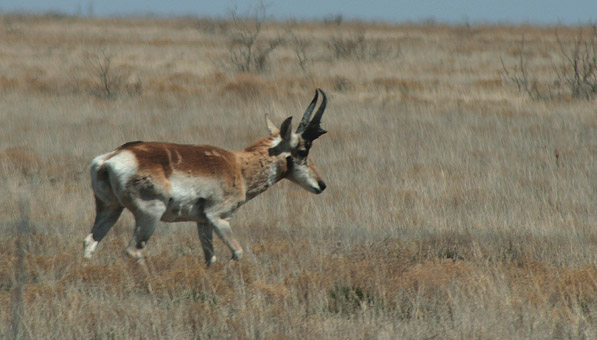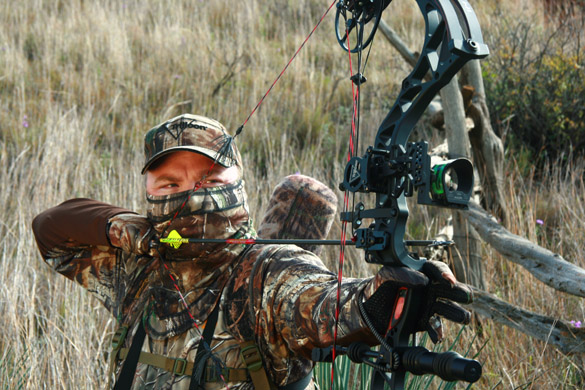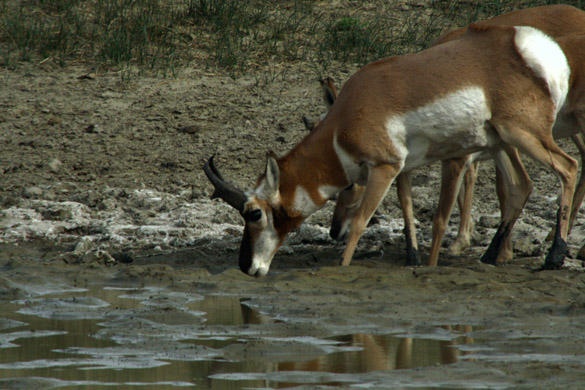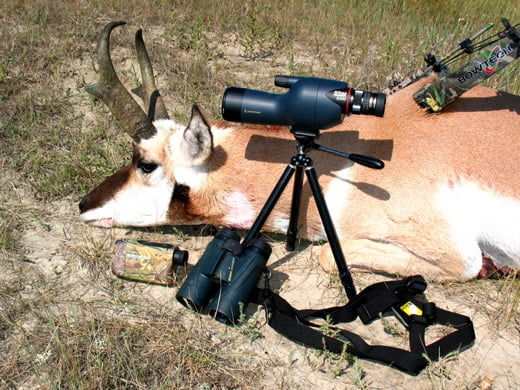LAST UPDATED: May 1st, 2015
Of course in the right country, during the right time, given enough animals – and enough luck – the right water-hole can turn archery pronghorn into a quick and relatively painless endeavor. Yet, for the most part, easy isn’t something you can count on when bowhunting antelope on today’s public lands. The best watering sites can be quickly snapped up by competing masses, rain puts a quick damper on activities, while too much water and/or too few goats can make water-hole hunting tedious or downright futile. In other words, sometimes a bowhunter’s got to get out there and make something happen the hard way; complete with long days behind the glass and miles of belly-crawl stalks. But then I’m really getting ahead of myself…
With a little research and an early application many bowhunters can secure a great location to arrow a pronghorn.
Secure A License
If you wish to bowhunt pronghorn you’ll probably have to first draw a tag. I hear there are over-the-counter archery tags in the Dakotas, but most speed goats there live on private lands, so gaining permission becomes the biggest hurdle. Montana and Wyoming (states harboring as many prongers as all other antelope states combined) offer archery tags with nearly assured draw odds (around 90 percent; especially, again, in areas dominated by private lands), but you still must submit an early application.
Everywhere else you’ll need to beat some odds in order to hunt at all. Draw odds seem to be directly tied to trophy quality. For instance, east-central Colorado has pretty decent draw odds for bowhunters, but trophy quality (and public access) is lackluster. Western New Mexico, Arizona and Nevada, on the other hand, annually produce some of the biggest speed goats in the country, but drawing tags is right up there with securing better elk tags – sometimes more difficult.
If you have a few dollars socked away you might purchase a private-landowner tag, particularly in New Mexico (the eastern portion of the state) or western Colorado (Ranching For Wildlife), just as examples. There’s not room here for a complete synopsis of pronghorn regulations across the West. That’s what the Internet’s for… Pick a state you may be interested in, or live near, and do some research.
Extending M.E.R.
Pronghorn success most often comes down to stubborn persistence, but just as often it hinges directly on M.E.R. Maximum. Effective. Range. Pronghorn country’s largely wide open and short on cover. Pronghorn possess eyesight equivalent to a human using 8x binoculars. Combine these factors and bowhunting pronghorn typically spells long-range shooting. How far is really up to you; how smart you’re willing to work, the equipment you shoot and how much patience is applied. Maximum effective range isn’t about poke-and-hope delusions; it’s about honing skills and fine-tuning equipment while also honestly accessing how far you can stand from a target and assemble five-of-five, 8-inch arrow groups.
Granted, pronghorn are thin skinned and light boned. A hit that might only inflict irritation on elk or even deer often proves fatal on antelope. Granted, lack of cover making it difficult to close the distance on prairie goats also means they have a difficult time getting out of sight after a marginal hit. It’s also true antelope don’t possess the tenacity of elk or deer. During my years as a big-game guide I helped recover a good number of marginally-hit pronghorn. But let’s understand this is no reason for sloppy shooting or inflicting unnecessary suffering. But reality is reality. The farthest I’ve killed a whitetail deer from stand; 47 yards (windmill, Colorado Eastern Plains). The farthest I’ve bagged a much-smaller pronghorn; 73 (spot-and-stalk, Western New Mexico). This didn’t happen by accident.
To even contemplate shooting at such ranges your equipment must be super-fine tuned. If needed, seek professional assistance. In short, small deviances in tuning unnoticed at ranges less than 40 yards begin to loom large with each five-yard increment added. The same can be said of shooting form. Step back to 60 yards and those misses measuring mere inches at 30 yards become feet. Again, seek professional assistance (shooting coach) when needed. My approach is to practice at 100-plus yards to hunt at ranges 30 or 40 yards less. This builds confidence and quickly reveals flaws in shooting form, forcing you to heed tiny details.
With long-range shots being a normal part of antelope hunting it is vital to practice at super-long ranges in order to make the average shot at a speed goat seem a little bit closer; thus increasing your chances of success.
Small changes to equipment setup can also help stretch your range. Pronghorn hunting is the only time I advocate super-light, super-fast carbon arrows (6.5 to 8.5 gpi in .340 deflections) in combination with aggressive mechanical broadheads. Faster arrows flatten trajectory to provide more forgiveness following slight ranging errors. Aggressive mechanicals are more streamlined at high speeds and spill more life juices should an arrow go off the mark.
Longer range also requires a different kind of sight than used on the whitetail stand. This hinges on real abilities, but many companies now offer 5- (20 to 60 yards) or 7-fixed-pin models (20 to 80), some with graduated pin diameters (larger top, smaller bottom), or aiming points terminating in fine .010-inch fiber optics. Another welcome addition to any pronghorn bow is a single-pin mover, the sight aperture moving vertically on a pivoting or gear-driven head. This allows adjusting a single pin to a very precise range and aiming spot on.
Finally, you have no business taking any shot past 30 yards without the use of a quality laser rangefinder. As ranges stretch, small increments in range estimate spell wide margins of error. Get it right before taking your shot, use a rangefinder.
Blind Ambitions
Pronghorn are so conspicuous atop their open habitat many seem to think they can arrive without scouting and go right to work. Of course you can, but if you want an “easy” hunt, it’s normally best to put in some time scouting and setting up an ambush near productive water. On public ground the best watering sights are often inconspicuous sites off the beaten path – spring heads or “buffalo wallows” many overlook – though in the most remote areas (or private lands) the classic stock pond or windmill tank can prove deadly effective.
Ground blinds offer perhaps the “easiest” method for arrowing a pronghorn. However, there are a few pitfalls involved with the process.
Determining which watering site will bring success often boils down to looking for concentrations of tracks, though I prefer to find a buck or group of bucks to target (the biggest trophies normally) and spy on them from afar to learn their daily habits, including where they prefer to drink. Sometimes they surprise you, showing you a road-ditch puddle or hidden spring overlooked by the public (normally the reason they got so big) you can hunt without disturbance. In well-watered areas or during periods of rain, they might show you a fence break used regularly to access an adjoining pasture, or reveal their favorite scrape site (pawed-out areas where droppings and urine are deposited as territorial markers).
When the conditions are right (dry, draught-like), watering holes can be deadly; attracting speed goats from afar.
Such sites provide an opportunity for blind ambush. In some areas this may indicate pick-and-shovel pit blinds (not legal everywhere) or a portable pop-up. Beware that in some states (Idaho for instance) setting up blinds on public lands means others may legally hunt from them. There’s also the unfortunate reality of inviting theft; one of the reasons I actually prefer pit or brush blinds. Obviously, setting up well ahead of season – when feasible — gives pronghorn opportunity to become accustomed to the presence of the blind – and stakes out the site from those with a sense of right and wrong.
When it comes time to sit your site don’t forget to bring along plenty of fluids, snacks and lunch and a good, thick book to occupy the long hours between appearances.
Snake-Bellying
Of course blind hunts are classic, even preferred, but the inability to hunt water shouldn’t discourage efforts. Many of my best pronghorn have come while stalking during rainy hunts, including a fine Montana recurve buck. The best results are found by driving past pan-flat ground and seeking broken or vegetated areas speed goats often wonder into. Rim-rock, mesa-edge and wash country, or simply a stand of shin-deep grass or sage, can give you an edge in cutting the distance. Vast areas of public lands are best here, giving you plenty of ground to cruise while seeking a promising situation.
When spot and stalk is the order of the day, be sure to equip yourself with the finest optics you can afford in order to size up potential shooters from afar. This will save time wasted on an animal you evindually decide to pass on.
Smart bowhunters equip themselves with knee pads (Rancho Safari, ranchosafari.com makes camouflage fleece models) and leather gloves to protect against sharp gravel, hard-packed earth and cactus spines. But before you start you’ll be doing a lot of glassing, looking for target animals initially, but also to study movements and helpful topography while making a plan. High-objective, steady glass are best for this work, something in the 10×42 class, with a spotting scope kept handy to size up trophy potential and pare vast habitat into more manageable pieces from available vantages. Sunscreen and a silent, high-volume water bladder are as essential in this dodge as light-hued (I prefer Realtree Max-1) and airy camouflage duds.
Nothing says Wild West like the prairie pronghorn, a denizen of the United State’s forsaken “fly-over” regions and attracting little tourist attention. There’s really nothing much to look at out there — unless you’re a hunter who shares an appreciation for subtler aspects of the great outdoors, like the hooked-horn American pronghorn.

 By
By 







